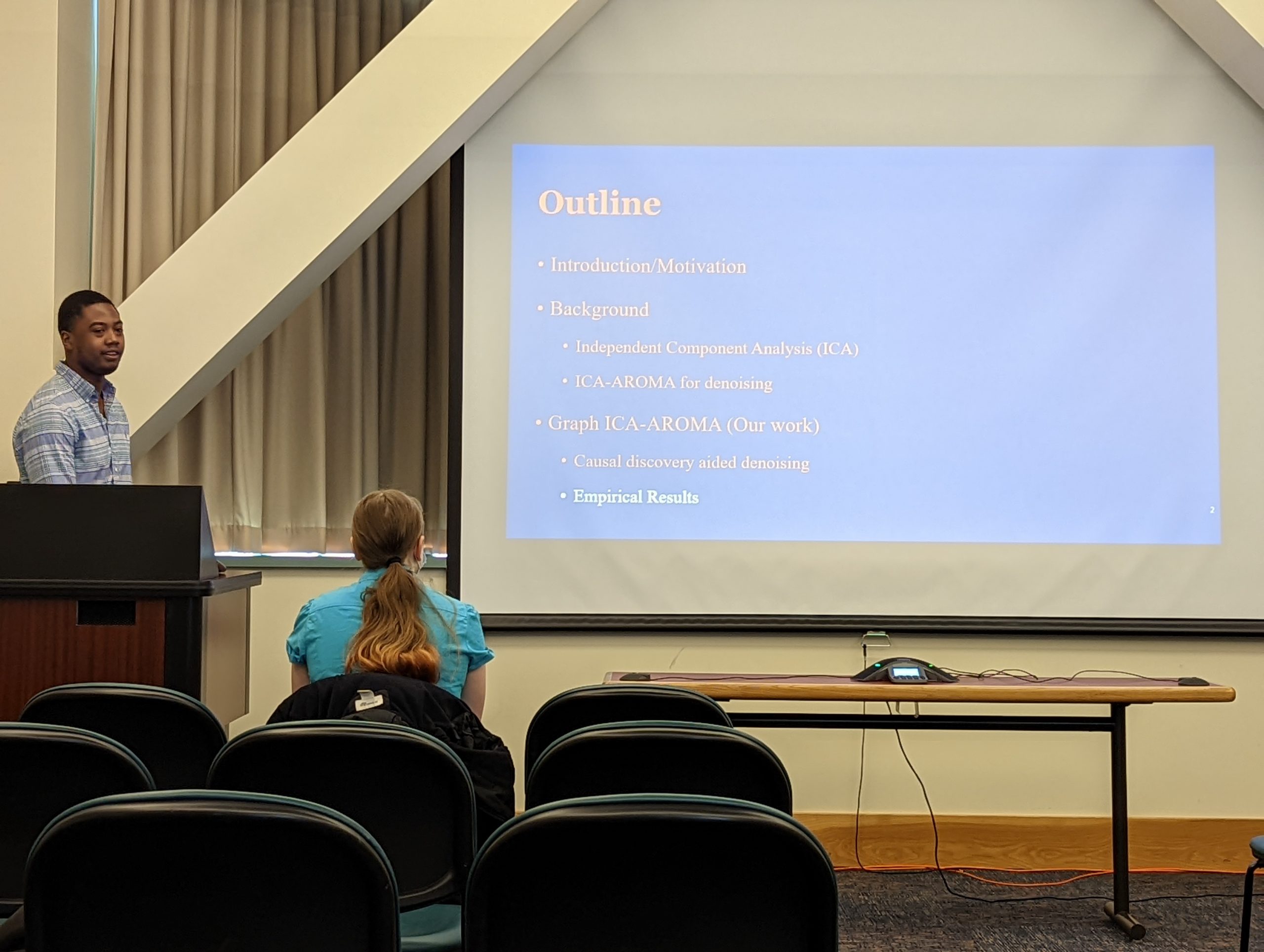 Olawale Salaudeen joined the program on September 16, 2021, while a third-year student, and is expected to graduate in 2024. His graduate program is computer science, and he completed his undergraduate degree in mechanical engineering at Texas A&M University.
Olawale Salaudeen joined the program on September 16, 2021, while a third-year student, and is expected to graduate in 2024. His graduate program is computer science, and he completed his undergraduate degree in mechanical engineering at Texas A&M University.
His current research is focused on causality-inspired machine learning with interests in applications to neuroscience and imaging; specifically, denoising in functional magnetic resonance imaging, or fMRI. He has conducted lab rotations under the advisement of Brad Sutton and Sanmi Koyejo. He has participated in the Special Topics in MBM course as well as other trainee activities such as Frontiers in Miniature Brain Machinery lectures and the annual MBM Retreat, where he presented his research in 2021 and 2022.
Of his first MBM Retreat, he reflects on the challenge of presenting a three-minute presentation of his research to an audience that was tangentially related to his work, but not very familiar with his approach. The short time limit only allowed a high-level overview: “This challenge was an excellent opportunity for growth. I not only had to filter my work to a few key points, but I also had to present them in such a way that the background necessary to appreciate the high-level takeaways was incorporated. This experience forced me to learn how to do this effectively.”
In the net spring, he was asked to give a ten-minute TED-style talk about his work – again, to a tangentially related audience, which presented a new challenge. “I found it difficult to choose which parts to go into more detail on and how much detail to include without getting into aspects that yielded more questions rather than more clarity. I relearned the important lesson that more detail does not necessarily imply more clarity,” he reflects.

In addition to those presentations, Salaudeen has more recently presented another ten-minute talk about his research at the 2022 MBM Retreat, where he also introduced Stephen Boppart’s plenary lecture. He has also introduced Esther Ngumbi’s public Frontiers in MBM lecture on “Communicating Your Research with the Public” December 1, 2021. He gave his Beckman Graduate Student Seminar in April 2022.
In April 2022, Salaudeen and fellow trainee Charles Marchini taught a lesson on covariance to 62 middle-school students over three class periods at Franklin STEAM Academy in Champaign, Illinois, to help students strengthen their knowledge of this mathematical concept. “This was a very valuable experience, as I had to boil down abstract concepts that they did not really have the background to easily grasp,” he explains. “I had to heavily rely on analogies to the things they already knew. I painted an incomplete picture, but a clearer picture than I would have been able to convey had I focused more on being rigorous.
“Overall, I learned that the level of rigor necessary for presentations can vary a lot based on the audience, and it is important to know whether the goal is to convey the intricacies of your work, which only people already close to it can fully appreciate, or to give a high-level synopsis that barely scratches the surface of the nuances of the topic but gives a broad summarization of the goals and importance of the topic.”
Salaudeen’s public outreach also includes his creation of two educational tutorials for K-12 learners, one on “Correlation vs. Causation” (2021) and another on “Tumor Classification using Machine Learning: An Application of Principal Component Analysis (PCA) and Covariance” (2022).
He was selected as a 2020 Beckman Institute Graduate Fellow and is also a Sloan Scholar (2021) and a GEM Associate Fellow. In April 2022 he delivered a Beckman Institute Graduate Student seminar and has attended multiple conferences, including the Tapia Conference for the Center for Minorities and People with Disabilities in IT in July 2022.
For his coursework in the traineeship, he took two courses in Neuroscience in the spring to meet the MBM course requirements: Brain, Learning, and Memory, and Integrative Neuroscience. “I found these courses to be very helpful in seeing the types of findings the methods I am developing may help discover,” he explains. “I also gained more understanding of the Neuroscience field, enough to be able to carry out a high-level conversation with Neuroscientists and identify potential collaborations.”
Salaudeen spent the summer of 2022 at an internship with Google Research in Boston. He has since been working remotely at Stanford University with Dr. Sanmi Koyejo.
Research Highlights (in his own words):
My core research is focused on the applications and implications of causality on problems relating to robustness. One application focus of my work has been neuroimaging, specifically how to mitigate the confounding effects of nuisance artifacts, such as motion and respiration, on scientific inferences that can be derived from functional magnetic resonance images (fMRI). We do this by leveraging a method called independent component analysis to decompose fMRI scans into independent spatial components and their corresponding temporal signatures. We then apply causal discovery to learn the structure between the temporal signals to determine a set of criteria that identify signals that are consistent with the nuisance signals we aim to remove.
We apply our method to two datasets to evaluate its efficacy: (1) INSIGHT and (2) Human Connectome Project (HCP) Young Adults. These two datasets represent two different types of subjects. The INSIGHT dataset is a collection of fMRI scans of active-duty airmen, while the HCP dataset consists of fMRI scans of young adults. Our current results suggest that we can do better than the competing nuisance artifact removal in yielding a denoised scan that leads to better prediction on tasks involving mapping connectivity to cognitive function. We also find that our method yields an improvement in the quality control metric QC-FC (Quality Control-Functional Connectivity) of fMRI. This provides evidence that our method is indeed removing more nuisance artifacts than the state-of-the-art, moving the community closer to capturing activity in the brain with more accuracy and precision.
Reflections on the Traineeship
The past year of experiences through the Miniature Brain Machinery (MBM) program has helped me improve and hone my skills in presenting my work to various audiences. I have had the opportunity to present my work to a range of audiences ranging from middle school students to faculty working in related areas. The opportunity to practice presenting the same information in a multitude of ways, tailored to the audience, has been invaluable.
Overall, I have improved not only my research and Neuroscience background knowledge in the last year, but also my scientific communication skills, which is a vital component of doing science for the social good.

